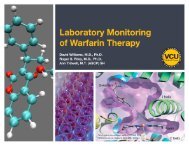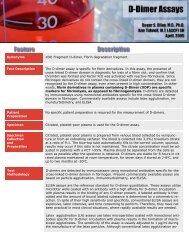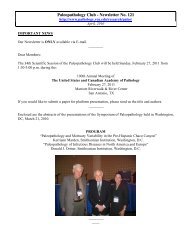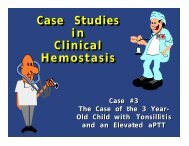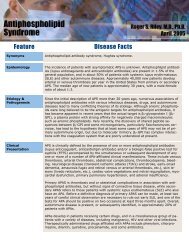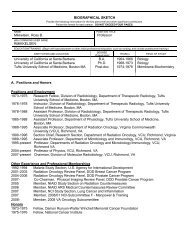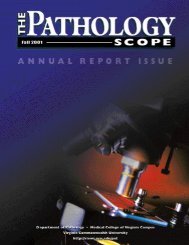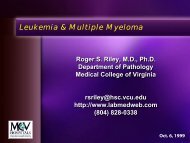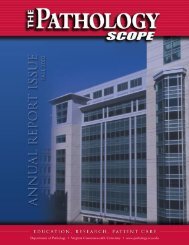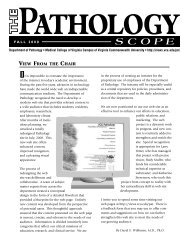What You Should Know About Abnormal Blood Clotting - Pathology
What You Should Know About Abnormal Blood Clotting - Pathology
What You Should Know About Abnormal Blood Clotting - Pathology
You also want an ePaper? Increase the reach of your titles
YUMPU automatically turns print PDFs into web optimized ePapers that Google loves.
Deadly <strong>Pathology</strong>/Killer <strong>Blood</strong> Clots<br />
Roger S. Riley, M.D., Ph.D.<br />
8<br />
Table IV<br />
Laboratory Assays for Thrombotic Disorders*<br />
<strong>Abnormal</strong>ity Coagulation Laboratory Assays Molecular Assays<br />
Antiphospholipid antibody Screen - Activated partial thromboplastin None<br />
syndrome<br />
time (aPPT)($25). Confirmation - dilute<br />
Russell Viper Venom assay (dRVVT)($100)<br />
Factor V Leiden APC resistance ($250) Factor V Mutation Assay ($325)<br />
Prothrombin G20210A<br />
mutation<br />
None<br />
Prothrombin G20210A mutation<br />
($325)<br />
Homocysteine abnormalities Plasma homocysteine levels ($175) MTHFR mutation ($325)<br />
Antithrombin III deficiency Antithrombin III function and levels ($200) None<br />
Protein C deficiency Protein C function and levels ($425) None<br />
Protein S deficiency Protein S function and levels ($375) None<br />
Increased factor VIII Factor VIII activity ($175) None<br />
Increased plasminogen Plasminogen activity and levels ($415) None<br />
Plasminogen Activator PAI-1 inhibitor assay ($230)<br />
None<br />
Inhibitor-1<br />
* The most common abnormalities are listed first. The approximate cost is only a guide; laboratory costs may<br />
vary considerably.<br />
Most deficient individuals presenting with thrombosis are managed acutely with heparin therapy, followed by long<br />
term oral anticoagulant therapy. Commercially prepared concentrates are available for use post-surgically and<br />
during parturition in AT III deficient individuals. Protein C concentrates are available on a compassionate use<br />
basis.<br />
Summary<br />
Thromboembolic diseases are presently the leading cause of death, and responsible for more than 1,000,000<br />
deaths/year in the United States alone. Fortunately, thromboembolic disease is preventable, and many recent<br />
scientific discoveries have lead to the ability to estimate a person’s disease risk, so that appropriate preventive<br />
therapy can be instituted. Most doctors agree that persons who have a strong family history of thromboembolic<br />
disease or who develop thrombosis at an early age (i.e.,



